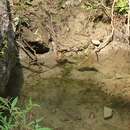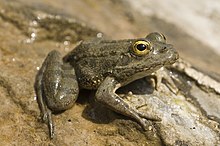en
names in breadcrumbs


Distribution in Greece:
Endemic: Karpathos, Rhodes.
General information:
Total length up to 7cm. Diurnal, shy frog that usually basks out of water. It will jump into the water when it feels threatened. It feeds mainly on invertebrates. It mates in spring and females lay their eggs in the water in clusters of a few hundred. Faces a high risk of extinction and it is classified as "Critically Endangered" in the red list of IUCN.
Εξάπλωση στην Ελλάδα:
Ενδημικό είδος: Κάρπαθος, Ρόδος.
Γενικές Πληροφορίες:
Τελικό μήκος έως και 7cm. Ημερόβιος, ντροπαλός βάτραχος που συχνά λιάζεται έξω από το νερό και βουτά μέσα σε αυτό μόλις αισθανθεί κίνδυνο. Ζευγαρώνει την άνοιξη και τα θηλυκά γεννούν αυγά σε αρκετές συστάδες μερικών εκατοντάδων μέσα στο νερό. Απειλείται με εξαφάνιση και κατατάσσεται στην κατηγορία "Κρισίμως Κινδυνεύοντα" στην κόκκινη λίστα τηςIUCN.
Προστατεύεται από:
Σύμβαση της Βέρνης, Παραρτήμα III
Der Karpathos-Wasserfrosch (Pelophylax cerigensis oder Rana cerigensis) gehört innerhalb der Ordnung der Froschlurche zur Familie der Echten Frösche (Ranidae). Außerdem wird er nach Aussehen, Lebensweise und Verwandtschaftsbeziehungen zu den Wasserfröschen gerechnet, die inzwischen von vielen Autoren in eine eigene Gattung Pelophylax gestellt werden. Der systematische Status wird kontrovers diskutiert; möglicherweise handelt es sich doch nicht um eine eigenständige Art. Sie ist ausschließlich auf den griechischen Inseln Karpathos und Rhodos vor der türkischen Mittelmeerküste anzutreffen.
Der Karpathos-Wasserfrosch ähnelt anderen Formen des Wasserfrosch-Komplexes. Eine klare Abgrenzung ist vor allem über molekularbiologische Merkmale möglich. Bisher wurden nur sehr wenige Individuen genauer erfasst und morphologisch beschrieben.
Das Verbreitungsgebiet des Karpathos-Wasserfroschs beschränkt sich auf die griechischen Inseln Karpathos und Rhodos. Dabei ist der Frosch auf Karpathos nur an einem kleinen, steinigen, weitgehend ausgetrockneten Fluss nahe der Stadt Olimbos sicher nachgewiesen worden. Auf Rhodos findet man ihn in waldreichen Höhenlagen, wo er schnell fließende, flache Bäche mit Schilf und Gebüschen besiedelt. Auch diese trocknen im Sommer oft aus.
Der Karpathos-Wasserfrosch gehört zum Formenkomplex der Wasserfrösche (Pelophylax), der systematisch noch nicht abschließend bearbeitet ist und aufgrund der vielfältigen Hybridbildungen nur schwer zu erfassen ist. Pelophylax cerigensis selbst gilt als Form mit ungeklärtem systematischen Status. Diverse molekularbiologische und auch landschaftsgeschichtliche Befunde legen den Schluss nahe, dass Wasserfrösche von Rhodos und Karpathos ursprünglich aus Anatolien stammten und vom Menschen eingebürgert wurden. Eine abschließende Bewertung zum Artstatus des Karpathos-Wasserfrosches ist aber derzeit nicht möglich.[1]
Der Karpathos-Wasserfrosch wird in der Roten Liste gefährdeter Arten der IUCN als stark gefährdet („Endangered“) eingestuft, weil er über ein relativ kleines Verbreitungsgebiet von weniger als 5000 km² verfügt und dieses stark fragmentiert ist. Zudem wird eine zunehmende Verschlechterung seiner Habitate festgestellt.[2] Die Hauptgefährdung für dieses Taxon geht von dem Verlust geeigneter Gewässer durch Verschmutzung und Trockenlegung durch die Landwirtschaft, den Tourismus und die Besiedlung seines Lebensraumes aus. Für diese Art wurden Schutzgebiete ausgewiesen und es laufen Forschungsprogramme um weitere Schutzmaßnahmen für diese Art festzulegen.
Der Karpathos-Wasserfrosch (Pelophylax cerigensis oder Rana cerigensis) gehört innerhalb der Ordnung der Froschlurche zur Familie der Echten Frösche (Ranidae). Außerdem wird er nach Aussehen, Lebensweise und Verwandtschaftsbeziehungen zu den Wasserfröschen gerechnet, die inzwischen von vielen Autoren in eine eigene Gattung Pelophylax gestellt werden. Der systematische Status wird kontrovers diskutiert; möglicherweise handelt es sich doch nicht um eine eigenständige Art. Sie ist ausschließlich auf den griechischen Inseln Karpathos und Rhodos vor der türkischen Mittelmeerküste anzutreffen.
The Karpathos frog (Pelophylax cerigensis) is a species of frog in the family Ranidae. It is endemic to the island of Karpathos, South Aegean Sea, Greece. The Karpathos frog is considered the most endangered anuran amphibian in Europe because its range is restricted to two small rivers in the north part of the island.[2]
Its natural habitats are Mediterranean-type shrubby vegetation, rivers, intermittent rivers, freshwater lakes, intermittent freshwater lakes, freshwater marshes, intermittent freshwater marshes, arable land and ponds. It is threatened by habitat loss.
The Karpathos frog (Pelophylax cerigensis) is a species of frog in the family Ranidae. It is endemic to the island of Karpathos, South Aegean Sea, Greece. The Karpathos frog is considered the most endangered anuran amphibian in Europe because its range is restricted to two small rivers in the north part of the island.
Its natural habitats are Mediterranean-type shrubby vegetation, rivers, intermittent rivers, freshwater lakes, intermittent freshwater lakes, freshwater marshes, intermittent freshwater marshes, arable land and ponds. It is threatened by habitat loss.

La Pelophylax cerigensis (Karpathos-rano) estas specio de ordo anuro, familio veraj ranedoj (Ranidae). Ĝi estas endema en Grekio sur insuloj Karpathos kaj Rodoso. Kelkaj aŭtoroj pridubas, ke ĝi estas aparta specio, laŭ ili, ĝi estis enportita el Anatolio.
Ĝia natura vivmedio estas la mediteran-tipa arbusta vegetaĵo, konstantaj kaj provizoraj riveretoj, lagoj, lagetoj, marĉoj, plugebla tero. Ĝin minacas perdo de la vivmedio.
La rana de Karpatos (Pelophylax cerigensis) es una especie de anuro de la familia Ranidae.[1]
Es un endemismo de la isla de Karpatos (Grecia). Anteriormente, también se incluían en esta especie las poblaciones de la cercana isla de Rodas, pero actualmente se considera que estas últimas pertenecen a Pelophylax bedriagae.
Su hábitat natural son los lugares de vegetación mediterránea, ríos, arroyos, lagos de aguadulce permanentes o temporales, marismas, tierra agrícola. Si principal amenaza es la pérdida de hábitat.
Pelophylax cerigensis Pelophylax generoko animalia da. Anfibioen barruko Ranidae familian sailkatuta dago, Anura ordenan.
Pelophylax cerigensis Pelophylax generoko animalia da. Anfibioen barruko Ranidae familian sailkatuta dago, Anura ordenan.
Pelophylax cerigensis, la Grenouille de Karpathos, est une espèce d'amphibiens de la famille des Ranidae[1].
Cette espèce est endémique de l'île de Karpathos en Grèce[2].
Cette espèce est principalement aquatique. Elle vit dans les eaux stagnantes ou ayant un faible débit[2].
Pelophylax cerigensis[3] mesure 42 à 67 mm. Son dos est gris brunâtre ou olive et présente ou pas de petites taches brun clair. Sa face ventrale est crème marbré de gris. Les sacs vocaux du mâle sont gris foncé.
Karpathos, une île où l'eau est rare, n'est occupée que par un faible nombre de petites populations de cette espèce aquatique[3]. Sa survie à long terme est incertaine et ce à cause de la déforestation, de la rareté de l'eau et de la dégradation de son habitat aquatique par l'homme. Elle est classée en danger critique d'extinction.
Son nom d'espèce, composé de cerig[o] et du suffixe latin -ensis, « qui vit dans, qui habite », lui a été donné en référence au lieu de sa découverte, Karpathos (Cerigo en latin).
Pelophylax cerigensis, la Grenouille de Karpathos, est une espèce d'amphibiens de la famille des Ranidae.
La rana d'acqua di Karpathos (Pelophylax cerigensis (Beerli, Hotz, Tunner, Heppich, and Uzzell, 1994)) è una specie di rana della famiglia Ranidae.[2][3]
È endemica dell'isola di Scarpanto (Grecia).[1][2]
Per la ristrettezza del suo areale e la esiguità della popolazione esistente, Pelophylax cerigensis è classificata dalla IUCN Red List come specie in pericolo critico di estinzione (Critically Endangered)[1].
La rana d'acqua di Karpathos (Pelophylax cerigensis (Beerli, Hotz, Tunner, Heppich, and Uzzell, 1994)) è una specie di rana della famiglia Ranidae.
Pelophylax cerigensis (anteriormente Rana cerigensis) é uma espécie de anfíbio da família Ranidae.
É endémica de Grécia.
Os seus habitats naturais são: matagais mediterrânicos, rios, rios intermitentes, lagos de água doce, lagos intermitentes de água doce, marismas de água doce, marismas intermitentes de água doce, terras aráveis e lagoas.[1]
Está ameaçada por perda de habitat.[1]
Pelophylax cerigensis (anteriormente Rana cerigensis) é uma espécie de anfíbio da família Ranidae.
É endémica de Grécia.
Os seus habitats naturais são: matagais mediterrânicos, rios, rios intermitentes, lagos de água doce, lagos intermitentes de água doce, marismas de água doce, marismas intermitentes de água doce, terras aráveis e lagoas.
Está ameaçada por perda de habitat.
Lykisk sjögroda (Rana cerigensis syn. Pelophylax cerigensis[2]) är en art i familjen äkta grodor som tillhör ordningen stjärtlösa groddjur.[4][5] Inga underarter finns listade i Catalogue of Life.[4] Arten beskrevs först av Beerli, Hotz, Tunner, Heppich och Thomas Marshall Uzzell, Jr. 1994.
Den lykiska sjögrodan tillhör samma grupp som epirusgrodan och är mycket lik denna.[6] Den är en medelstor groda med en medellängd på 5,5 cm. Ovansidan är vanligen ljust brungrå till olivfärgad, och kan ha ljusbruna fläckar; en variant med gräsgrön ovansida och klarbruna fläckar finns också. Undersidan är ljusbeige och spräcklig i grått. Hanen har mörkgrå strupsäckar.[7]
Arten lever framför allt i stillastående vattensamlingar och långsamma vattendrag, där det antas att även parningen och larvutvecklingen äger rum.[1]
Den lykiska sjögrodan finns endast på den grekiska ön Karpathos, troligtvis endast i en lokal.[1] Vissa äldre källor anger dock att den även skall förekomma på Rhodos.[6] [7]
Grodan är klassificerad som akut hotad ("CR", underklassificering "B1ab(iii)+2ab(iii)"), och populationen är i avtagande. Orsaken är främst förlust av lämpliga habitat på grund av kraftig vattenförbrukning. Klimatförändringar tros också spela en roll.[1]
Lykisk sjögroda (Rana cerigensis syn. Pelophylax cerigensis) är en art i familjen äkta grodor som tillhör ordningen stjärtlösa groddjur. Inga underarter finns listade i Catalogue of Life. Arten beskrevs först av Beerli, Hotz, Tunner, Heppich och Thomas Marshall Uzzell, Jr. 1994.
Pelophylax cerigensis là một loài ếch thuộc họ Ranidae. Đây là loài đặc hữu của Hy Lạp.
Môi trường sống tự nhiên của chúng là thảm cây bụi kiểu Địa Trung Hải, sông ngòi, sông có nước theo mùa, hồ nước ngọt, hồ nước ngọt có nước theo mùa, đầm nước ngọt, đầm nước ngọt có nước theo mùa, đất canh tác, và ao. Chúng hiện đang bị đe dọa vì mất môi trường sống.
Phương tiện liên quan tới Pelophylax cerigensis tại Wikimedia Commons
Pelophylax cerigensis là một loài ếch thuộc họ Ranidae. Đây là loài đặc hữu của Hy Lạp.
Môi trường sống tự nhiên của chúng là thảm cây bụi kiểu Địa Trung Hải, sông ngòi, sông có nước theo mùa, hồ nước ngọt, hồ nước ngọt có nước theo mùa, đầm nước ngọt, đầm nước ngọt có nước theo mùa, đất canh tác, và ao. Chúng hiện đang bị đe dọa vì mất môi trường sống.